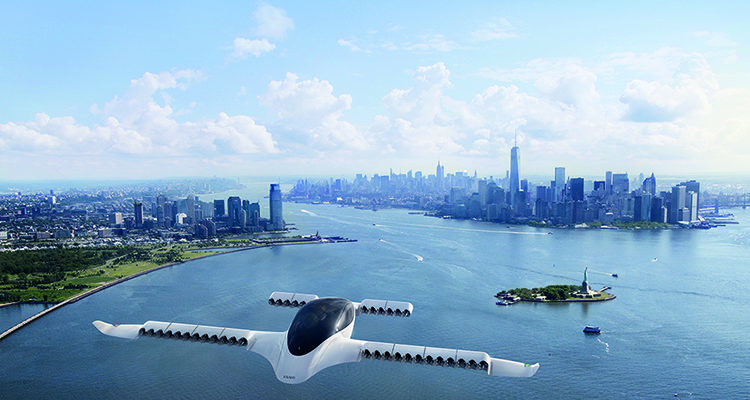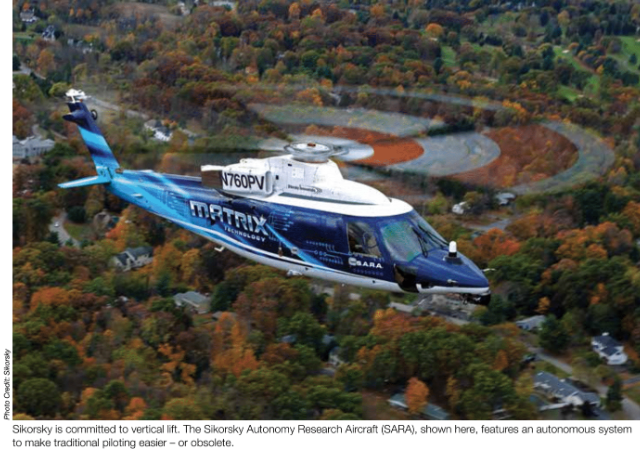Last fall, Lilium completed its first phase of flight testing, flying at speeds exceeding 62 mph. Its goal is to reach up to 186 mph in one hour on a single charge. The company also built a 9,800-square-foot manufacturing plant for serial production of its eVOTL and is currently building a second facility.
Achieving these milestones takes funding, and Lilium has attracted numerous investors. In late March, the company obtained funding of more than $240 million, bringing the total sum raised in five years to more than $340 million. The newest investor, Chinese multinational conglomerate holding company Tencent, joins existing venture capitalist investors Atomico, Freigeist and LTM.
Sikorsky Innovations, founded in 2010 to advance vertical flight, builds on the long tradition of helicopter production at Sikorsky. “We do not have an active development project for a vehicle specifically at this moment, but we’ve been working on several key technologies,” says Hartman. These include electric propulsion, fleet management and autonomy.
Since 2013, Sikorsky has invested in a technology called MATRIX™, which combines hardware and software components to enable autonomous or optionally-piloted aircraft. “MATRIX allows us to reduce the workload on the pilot, turning stick-and-rudder controls into touch-and-go pilot interfaces,” says Hartman. “As we continue to mature and deploy the technology, urban air mobility is certainly one of those applications under consideration.”
NASA also has several projects related to UAM, although the agency has begun pivoting to the term AAM – Advanced Air Mobility. “AAM reflects that the basic technologies surrounding UAM can enable a whole range of new missions and new cases not restricted to urban areas,” says Goodrich. Goods and people could be transported locally, regionally or interregionally.
NASA’s research and development in AAM is comprehensive. “It cuts across most of the aeronautics areas that NASA has historically worked in,” says Goodrich. “The only things outside the scope of AAM are supersonic and hypersonic flight.”
The agency has identified five pillars of technology that must be addressed to move AAM forward: basic aircraft design, piloting, design of an overall airspace architecture, real-time operation in that airspace and community integration. Goodrich says NASA has active projects in all five areas.
Earlier this year, NASA launched the Advanced Air Mobility National Campaign (formerly the UAM Grand Challenge) to promote public confidence and accelerate the AAM movement. In March, the agency signed agreements with 17 companies in the aviation industry to participate in developmental flight testing, airspace simulation and vehicle provider information exchange.
The Role of Composites
The complexity of the UAM movement will require innovative composite solutions. “It’s a paradigm shift with a lot of unknowns, and in the face of unknowns we hunt down the highest-tech, best option available on the market,” says Uzman of Coriolis Composites USA. “Every pound that we save on the aircraft structure is crucial to making the platform a success.” Less weight in the aircraft allows for more weight in the battery, which will allow the vehicle to fly longer and farther.
Coriolis Composites has teamed with several companies building UAM vehicles and installed AFP machines at their facilities. Traditionally, the equipment has been used to manufacture components for large, wide-bodied commercial airlines. By contrast, UAM vehicles are much smaller and require complicated features. This is where Coriolis AFP equipment “shines,” says Uzman.
“For the number of tows placed, our equipment head has the smallest form factor. So it can get into very tight spaces and lay up very complicated parts,” he says. “With the additive manufacturing process, you can do lots of things with fiber placement through automation that you can’t do through manual layup.” Coriolis Composites’ customers are primarily using carbon fiber prepregs with epoxy resins, though some are looking into thermoplastic composites.
The company is also focused on automated inspection and verification of parts for the UAM market. “The market segment is talking about thousands of aircraft a year, so manual inspection isn’t an option. It has to be automated,” says Uzman. At least two companies plan to roll out Coriolis Composites’ automated inspection and verification solutions at their plants this year.
“It remains to be seen how they will qualify these systems and get the FAA to agree that this is an adequate inspection process or if human-in-the-loop inspection is required,” says Uzman. “It’s uncharted territory.”
Advice for Composites Companies
The question of when UAM will become a reality is a tricky one, dependent largely on what’s considered a milestone. (For example, drone delivery of packages compared to full air taxi service.) Sherman of the Vertical Flight Society speculates that if flight demonstrations occur this year, then UAM could be operational by 2023. Shestopalov with AiRXOS believes flights over water – for instance, taking off at San Francisco International Airport and landing on a heliport near your destination in the San Francisco Bay – could happen within the next five years. But she says the real shift, “providing a flight somewhere that costs what an UberX costs now,” is at least 10 years out.
There are several steps composites companies can take to help propel the UAM movement forward, including these four:
Form partnerships with unexpected companies. Last year, Sikorsky collaborated with Otis Elevators, which invented the first safety elevator and moves billions of people daily. UAM has the ability to connect destinations the same way that an elevator first connected floors together, allowing for skyscrapers and today’s modern cities, says Hartman. “When was the last time you heard about an aerospace company talking to an elevator company?” he says. “Those are the types of non-traditional relationships we are going to need to make this work.”
Serve as advisors to OEMs. As the market matures, it will require 10,000 to 20,000 vehicles a year, says Sherman. “Bell, Boeing, Airbus and other OEMs can’t produce aircraft at that rate, so they will need some education and assistance from composites companies that can produce at automotive rates,” he says.
Focus on the big picture, not just the aircraft. Sikorsky is a founding member of the World Economic Forum’s UAM Working Group that brings together industry, policy makers, academia and public sector leaders to develop a global plan for UAM. “We need to start thinking about UAM from a holistic level down as we are also doing bottoms-up building of air vehicles,” says Hartman. “As an industry, we are committed to and excited about designing new things, but we have to take a moment and ask about all the requirements those new things are going to fall under.”
Continue pushing the performance of composites. “I would surmise that a lot of the applications we are talking about are really going to push the envelope on composite performance,” says Hartman. “We’re going to ask composites to do things they haven’t done before and operate in ways they haven’t before.” For instance, some companies are considering structural batteries that integrate composites with battery materials so the battery serves as both an energy storage device and a structural component.
These are exciting times for an industry like composites that thrives on innovation. “Over the next 30 years, there’s a transformational opportunity to introduce new multimodal mobility,” says Hartman. “We’re going to have to look beyond spec sheets and catalogs and work collaboratively as an entire supply chain and technology base to go forward.” And to go up into the third dimension.




